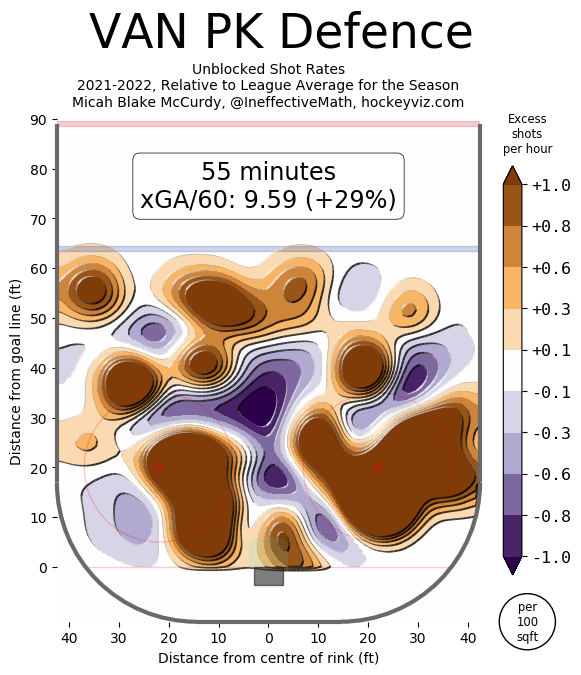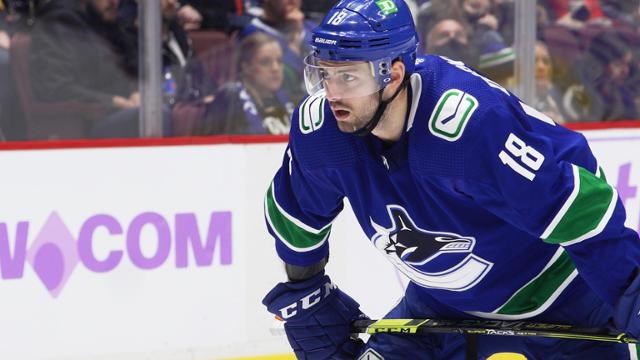The Vancouver Canucks seemed to find a solution to their power play woes on Sunday, scoring three goals with the man advantage after four games without even one. The other half of their special teams, however, still needs some tinkering.
Actually, it likely needs a full-on overhaul. After four-straight games where they gave up two power play goals, the Canucks’ penalty kill is the worst in the NHL.
The Canucks have killed off just 23 of 36 penalties this season, a dreadful 63.9% success rate that ranks dead last in the NHL. Only the Montreal Canadiens have allowed more power play goals this season and they’ve been shorthanded 11 more times than the Canucks.
For perspective, if the Canucks maintained this penalty kill percentage for the entire season, it would be the worst penalty kill in NHL history or at least the worst penalty kill since the league started tracking the statistic. The worst penalty kill in history belonged to the 1979-80 Los Angeles Kings, who killed off 68.2% of their penalties.
Of course, the season is still young and the Canucks can still turn things around on the penalty kill. They’re going to have to if they want any chance of making the playoffs.
Significant changeover of penalty kill personnel
The Canucks knew the penalty kill might be a problem heading into the season. The team lost four of their primary penalty killers this summer — Alex Edler to free agency and Nate Schmidt, Antoine Roussel, and Jay Beagle to trades.
Making matters worse, Tyler Motte has taken a long time to recover from offseason neck surgery and there’s no timeline for the return of Brandon Sutter, who is dealing with fatigue. Canucks general manager said that Sutter is still experiencing COVID-19 symptoms months after contracting the virus during the Canucks’ outbreak.
“I guess they call it being a long hauler,” said Benning in October. “He still has some issues he's working through with that. So, once he's feeling better, the first step for him is to get feeling better and then once he's healthy enough and feeling better, he'll start working out and get back out on the ice.”
Motte and Sutter were expected to be the Canucks’ primary penalty-killing forwards. Their absence means the Canucks have had to rely on players that might otherwise play more of a depth role on the penalty kill.
J.T. Miller has played the most on the penalty kill of any Canucks forward this season, followed closely by Juho Lammikko, who the Canucks traded for when it became clear Sutter wouldn’t be available. After those two, the Canucks have used Jason Dickinson, Matthew Highmore, and Justin Bailey.
On defence, Oliver Ekman-Larsson and Tyler Myers have been the go-to defencemen, with Tucker Poolman playing with whoever else is available: Kyle Burroughs, Luke Schenn, and Travis Hamonic, now that he’s returned to the lineup.
It’s a bit of a motley crew and the results haven’t been pretty.
The numbers match the eye test
It’s not just bad luck, either. The Canucks allow the highest rate of shot attempts on the penalty kill according to Natural Stat Trick and the heatmap of shots they give up on the penalty kill via HockeyViz is ugly.

The gold areas are where the Canucks have given up a higher than average number of shots on the penalty kill. According to HockeyViz, the Canucks have given up shots that are 29% more dangerous than the NHL average.
Surprisingly, that’s not the worst mark in the NHL. The Ottawa Senators (+30%) and Vegas Golden Knights (+39%) are somehow worse.
Shot location doesn’t tell the whole story, of course. That heatmap doesn’t show all of the pre-shot puck movement that the Canucks give up on the penalty kill. The Canucks’ biggest issue is that they haven’t been able to close off passing lanes, allowing far too many cross-seam passes.
The opening goal from the Dallas Stars on Sunday illustrates the issue nicely.
The Canucks’ penalty kill is in scramble mode immediately, chasing the puck instead of settling into a solid formation and taking away passing lanes. It’s far too easy for Roope Hintz to pass through the penalty killing box to Jason Robertson and then it’s far too easy for Robertson to slip the pass through the box again to Joe Pavelski at the backdoor.
J.T. Miller, who was on the ice for that goal, admitted there was a breakdown on that play but was quick to defend their penalty killing later in the game.
“There were some mistakes on the first one, like when a faceoff doesn't get out, I let a seam through, Bails [Justin Bailey] and I take the wrong route. It wasn't a pretty goal, by any means, but there was a breakdown, I think,” said Miller. “But on the one to start the third, we were playing it textbook. We had changed probably five or six times in four minutes, maybe more than that and they couldn't even get set up and one wrist shot gets deflected.”
The Canucks might hope that their work on the four-minute penalty kill in that third period might be a hopeful sign but they still gave up a goal. In any case, the cross-seam passing they gave up on the first goal was far more reflective of how the penalty kill has played all season.
Canucks have the worst shorthanded faceoff percentage in the NHL
That goal started with a faceoff win by the Canucks that they couldn’t clear. A bigger problem for the Canucks this season has been winning that faceoff in the first place. The Canucks have the worst faceoff percentage on the penalty kill in the NHL at a brutal 29.7%.
While winning faceoffs in general doesn’t correlate with winning games, they can make a difference on special teams. It seems obvious why: a faceoff win and a clear on the penalty kill can wipe out crucial seconds and forces the opposing power play to try to gain the offensive zone, which is another opportunity to break up the play and send the puck back down the ice.
“We've got to win more faceoffs for starters,” said head coach Travis Green after the Canucks’ allowed two power play goals against the Nashville Predators. “You look at our faceoffs tonight on special teams. It's a simple thing, but it matters. On the powerplay, you start with the puck; on the penalty kill, you get the clear. There was a time in the first period where we lost I think six faceoffs in a row.”
The big issue for the Canucks is that with Jay Beagle and Brandon Sutter gone, they don’t have enough centres who can reliably win faceoffs.
Of the Caanucks’ five centres who have regularly taken faceoffs this season, only Bo Horvat and J.T. Miller have won over 50%. Lammikko is at 46.0%, Dickinson is at 37.0%, and Elias Pettersson is last at 29.0%.
Regrettably, Horvat has historically been quite bad on the penalty kill and it’s understandable why the Canucks have been hesitant to use him in that situation. That leaves Miller as their best faceoff man for the penalty kill and he leads the Canucks in shorthanded faceoffs with 27. Unfortunately, he’s only won 8 of those for a 29.6% faceoff percentage.
Dickinson has been even worse, going 2-for-11 for an 18.2% faceoff percentage on the penalty kill.
"Honestly, I didn't sleep very well after the game on Friday."
For Dickinson, the Canucks’ struggles on the penalty kill have been keeping him up at night.
“Honestly, I didn’t sleep very well after the game on Friday because right there, that was the difference,” said Dickinson of the game against the Predators. “If we’re able to get those kills, we’re looking at a different game.”
The question for the Canucks is what can they do to fix the problem? It’s one thing to diagnose the issue — it’s quite another to cure it.
Motte has been back practicing with the team of late and is close to returning, which will help. As a winger, he won’t do much to fix the faceoff issue, though — Motte is a career 34.1% on faceoffs when he’s been called into the circle.
Perhaps it’s time to try some different personnel. Green has repeatedly said that penalty killing at the NHL level takes time to learn but the veterans on the penalty kill haven’t been cutting it.
What changes can the Canucks make to the penalty kill?
Young players like Nils Höglander and Vasily Podkolzin have killed penalties in international competition, even if they weren’t always trusted to do so in men’s leagues. Jack Rathbone has been killing penalties since being sent down to the AHL and could so so again when he inevitably gets called up.
Then there’s Pettersson. The Canucks’ star forward is an offensive dynamo — well, he was prior to the start of this season — but he also has a well-developed defensive game. There’s a reason people were comparing him to Pavel Datsyuk in his rookie year and not just because of his magic hands.
It should come as no surprise that a 3-time Selke winner like Datsyuk was a regular on the Detroit Red Wings penalty kill. Should Pettersson get the same opportunity?
It would be a much easier argument to make for Pettersson, of course, if he was better at faceoffs. If Pettersson was regularly winning 50% of his draws, giving him a chance to do the same on the penalty kill would make a lot of sense. As it is, he’d be playing on the penalty kill as a winger.
If there’s a solution beyond changing up the personnel, it’s not an obvious one. The Canucks’ penalty killing system in the defensive zone is essentially what most NHL team’s use these days, known as a wedge+1 or triangle+1. Essentially, three penalty killers form a triangle to protect the front of the net and slot, while one player pressures the puck.
Compared to the standard box penalty kill, the wedge+1 is a very active penalty killing formation that requires a lot of awareness on the part of the penalty killers to know where to go, when to rotate to become the “+1” and where to position your body and stick to take up passing and shooting lanes. When done right, however, it’s very effective.
Perhaps the Canucks could have more success by simplifying their system and returning to a simple box but there are perils with that approach. Power plays have many ways to exploit the more passive nature of the box and the end result could be even worse.
That said, a simple box might result in fewer cross-seam passes, even if it allows easier puck movement around the outside.
Whatever the solution might be, it’s clear that something needs to change. The Canucks can’t expect to make the playoffs giving up so many goals on the penalty kill.




